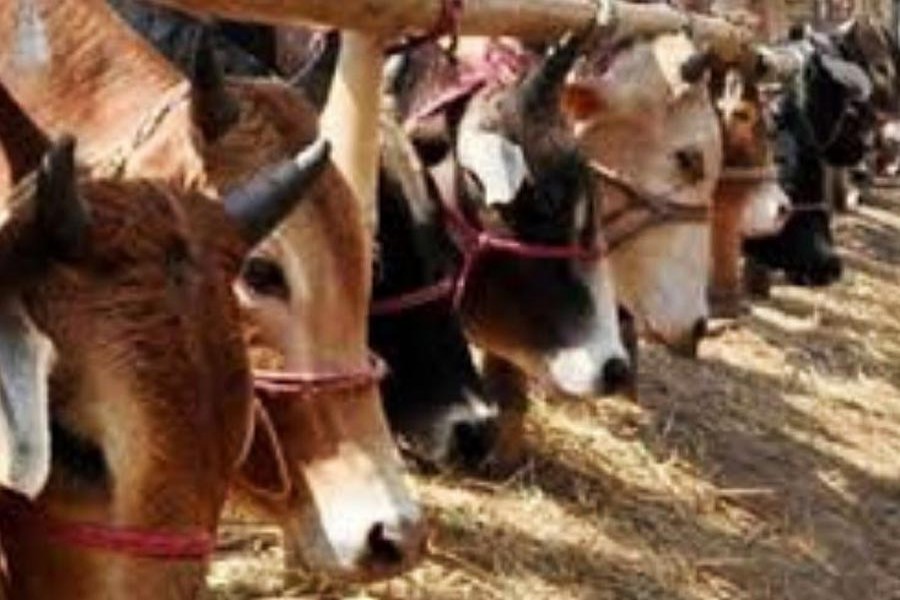
Published :
Updated :

The government will take an initiative to ensure smooth management of sacrificial animals, reared by commercial and marginal farmers across the country, ahead of Eid-ul-Azha amid the Covid-19 pandemic.
Department of Livestock Services (DLS) will also take measures to ensure health guidelines at each cattle market by forming medical teams.
Like past several years, sacrificial animals are in surplus in the country this year too thanks to commercial and marginal farmers.
This year 11.90 million cattle are available for sacrifice against the total demand for 11.20 million, according to DLS.
Some 11.78 million cattle were available for sacrifice last year against the total demand for 11.20 million, the DLS statistics showed.
Dr. ABM Khaleduzzaman, DLS assistant director (farm), said there will be no dearth of cattle ahead of Eid as commercial farmers along with household farmers put a lot of effort into rearing animals amid the coronavirus pandemic.
"Our medical teams will remain alert and vigilant due to the outbreak of Covid-19. They will implement health guidelines along regular set of works at cattle markets," he told the FE.
A total of 4538,000 cows and buffaloes, 7,355,000 sheep and goats and 4,500 other animals like camel and 'dumba' are set to be sacrificed during this Eid.
Under the government's cow-fattening programme, these animals have been reared at 577,416 farms, according to official statistics.
In addition, many households raise cows, sheep and goats, keeping the second largest religious festival of the Muslims in mind.
As many as 11,588,923 cows, sheep and goats were available in 2018 while 11,557,000 in 2017, according to the official data. Of them, some 10.50 million were slaughtered during last Eid-ul-Azha.
Sajib, an owner of Nazma Agro Farm in Madaripur, said he wants to sell his 10 bulls at prices ranging between Tk 100,000 and Tk 120,000.
The cost of rearing cattle has risen and it is the real problem right now, Islam said, adding that he fears an influx of imported cattle.
"The government should stop cattle import so that farmers like me don't incur heavy losses." It should take a tough stance on cattle smuggling, he said, adding that he incurred loss last year as the demand for cattle was low.
Md Shah Imran, secretary of Bangladesh Dairy Farmers' Association (BDFA), said there may be no shortfall of sacrificial animals during this Eid as commercial and marginal farmers reared a large number of cattle this year.
As cattle supply outstripped the demand last year, there is a little possibility of its dearth, he claimed.
Mr. Imran expressed fears whether farmers will be able to sell their cattle at fair prices due to slowdown in economic activities.
He also put emphasis on setting up of makeshift indoor market to ease the sufferings of both customers and traders during the rainy season.
Dr. ABM Khaleduzzaman said there were 2,400 cattle markets including 24 in city corporations last year and 1,200 medical teams worked at those markets.
This year the number of cattle markets may decline due to the Covid-19 crisis, he hinted.
DLS also has provided training to 24 professional butchers in each district through its divisional offices across the country, he stated.
During the shutdown in last three months, commercial and marginal farmers transacted Tk 26 billion through mobile marketing management across the country, the assistant director said.
The mobile marketing management will continue to benefit the farmers.
The cattle, sheep and goat population increased to 55.52 million in FY '19 from 49.55 million in FY '09, according to DLS.
The total livestock population (both ruminant and non-ruminant) reached about 402.56 million in FY '19. The share of livestock in the agriculture sector's gross domestic product (GDP) stood at 13.46 per cent in FY 2019.
The size of the livestock economy was estimated at Tk 432.12 billion, according to the DLS, with its contribution to the GDP estimated at 1.47 per cent.
The livestock is now creating jobs for 20 per cent of the total population directly and 50 per cent indirectly, the data available with the DLS show.
A total of 70,981 cattle farms was registered with DLS until August 2019. Of them, about 59,274 were dairies, 4,201 goat-rearing farms and 3,753 sheep farms.


 For all latest news, follow The Financial Express Google News channel.
For all latest news, follow The Financial Express Google News channel.